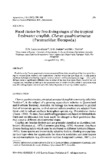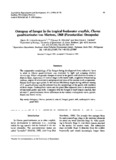Viral infections in Australian freshwater crayfish
- Global styles
- MLA
- Vancouver
- Elsevier - Harvard
- APA
- Help

View/
Date
2002Author
Page views
512AGROVOC keyword
Taxonomic term
Metadata
Perlihat publikasi penuh
Share
Abstract
Viral diseases of freshwater crayfish are poorly understood. To date, much of the research in this field has been conducted in Australia and/or on Australian freshwater crayfish species. Cherax tenuimanus, Cherax destructor and Cherax quadricarinatus are the predominant freshwater crayfish species cultured in semi-intensive systems in Australia. All three species have been translocated internationally for aquaculture. Viral infections have been reported in C. quadricarinatus and C. destructor, most reports are based on a limited number of cases (often only one or two animals). Consequently, for most of these viruses there is only limited or preliminary data on their epizootiology and pathogenicity. Infections by intranuclear bacilliform viruses (morphologically resembling the penaeid baculoviruses), parvo-like viruses, a reo-like virus, a picorna-like virus and a novel dsRNA intranuclear virus have been reported to infect Australian freshwater crayfish. This report will briefly review the current knowledge on viral infections in Australian freshwater crayfish.
Suggested Citation
Edgerton, B. F. (2002). Viral infections in Australian freshwater crayfish. In C. R. Lavilla-Pitogo & E. R. Cruz-Lacierda (Eds.), Diseases in Asian aquaculture IV: Proceedings of the Fourth Symposium on Diseases in Asian Aquaculture, 22-26 November 1999, Cebu City, Philippines (pp. 173-184). Fish Health Section, Asian Fisheries Society.
Type
Conference paperISBN
9718020160Koleksi
Related items
Showing items related by title, author, creator and subject.
-
Foregut evacuation, return of appetite and gastric fluid secretion in the tropical freshwater crayfish, Cherax quadricarinatus
Loya-Javellana, Gilda N.; Fielder, Donald R.; Thorne, Malcolm J. (Elsevier, 1995)The effects of animal size and feeding frequency on the foregut evacuation rates by Cherax quadricarinatus, that fed voluntarily on pellet food (meal size eaten, 1.3–1.4% body weight), were determined using a modified ... -
Food choice by free-living stages of the tropical freshwater crayfish, Cherax quadricarinatus (Parastacidae: Decapoda)
Loya-Javellana, Gilda N.; Fielder, D. R.; Thorne, M. J. (Elsevier, 1993)Food choice by Cherax quadricarinatus was measured from video recordings of the time spent feeding on decayed plant material and zooplankton. Crayfish within the size range 20–75 mm spent a significantly longer time feeding ... -
Ontogeny of foregut in the tropical freshwater crayfish, Cherax quadricarinatus von Martens, 1868 (Parastacidae: Decapoda)
Loya-Javellana, Gilda N.; Fielder, Donald R.; Thorne, Malcolm J. (International Society of Invertebrate Reproduction and Development, 1994)The comparative morphology of the foregut during development from embryonic larva to adult in Cherux quadricarinatus was examined by light and scanning electron microscopy. Major ontogenetic changes occurred in the gastric ...





